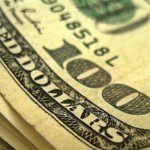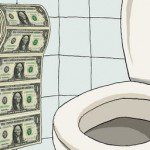Year-to-date, the dollar index, a trade weighted index comparing the U.S. dollar to a basket of six major currencies (Euro @ 57.6% weight, Japanese yen 13.6%, Pound sterling 11.9%, Canadian dollar 9.1%, Swedish krona 4.2% and Swiss franc 3.6%) is up 2.95% as of April 29, 2013 – but the U.S. Dollar Index is not the U.S. Dollar. To ascertain what may happen to the U.S. dollar, let’s look at the greenback from a couple of different angles.
basket of six major currencies (Euro @ 57.6% weight, Japanese yen 13.6%, Pound sterling 11.9%, Canadian dollar 9.1%, Swedish krona 4.2% and Swiss franc 3.6%) is up 2.95% as of April 29, 2013 – but the U.S. Dollar Index is not the U.S. Dollar. To ascertain what may happen to the U.S. dollar, let’s look at the greenback from a couple of different angles.
So writes Axel Merk (www.merkinvestments.com) in edited excerpts from his original article* entitled The Myth of the Rising Dollar.
(NOTE: This post is presented by Lorimer Wilson, editor of www.munKNEE.com and the free Intelligence Report newsletter (see sample here). The article may have been edited ([ ]), abridged (…) and/or reformatted (some sub-titles and bold/italics emphases) for the sake of clarity and brevity to ensure a fast and easy read.
Submit your own articles & article suggestions here (earn a “Hat Tip” acknowledgement) for posting consideration. “Follow the munKNEE” daily posts via Twitter or Facebook. These paragraphs must be included in any article re-posting to avoid copyright infringement.)
Myth: U.S. Dollar a Safe Haven
In recent years, when there has been talk about a “flight to quality” benefiting the U.S. dollar, we had a couple of observations:
- Flight to quality may be a misnomer: our analysis suggests the dollar tends to be in demand in times of turmoil because of liquidity, not quality considerations;
- The balance sheet of the U.S. appears to be deteriorating at a faster pace than the balance sheets of much of the rest of the world;
- Since the onset of the financial crisis, each time the pendulum swings in favor of the dollar, it may be swinging there less so;
In other words, the safe haven status of the U.S. dollar may slowly be eroding.
Myth: Rising Rates Favor U.S. Dollar
Assuming one believes interest rates are to head higher, it may be an expensive proposition to buy the U.S. dollar: as foreigners have historically had a major appetite for U.S. debt, their enthusiasm is often trimmed back as the bond market turns into a bear market.
Historically, early to mid phases of tightening by the Fed have often been associated with a weaker dollar.It’s the late phases of a tightening cycle that the dollar historically tends to benefit, as the next bull market is anticipated for bonds. There may be little historic precedent for the environmentwe are in, but in our assesment a rising rate environment does not favor the U.S. dollar.
Myth: Fed’s Exit Near
It was just about a year ago that Fed Chair Ben Bernanke pronounced in a press conference: Let’s be humble. He then clarified that meant that liquidity should not be mopped up too early; that we have to be sure that the recovery is firmly entrenched before one should consider an exit from the highly accommodative monetary policy.
To understand Bernanke, consider that in his own words, he has repeatedly stated that one of the biggest mistakes during the Great Depression was to raise rates too early. As a result, the Fed has promised to keep rates low, purchased longer-term bonds, and engaged in Operation Twist. All of these policies reflect an effort to keep long-term rates low yet, a little over a year ago, a series of good economic data points caused the bond market to sell off rather sharply on the long end. In our assessment of Bernanke’s thinking, that was undesirable as the recovery was nascent. Hence, the Fed doubled down by announcing an unemployment rate numerical threshold that would guide rate policy, moving the focus evermore away from inflation and towards employment. Not surprisingly, inflation expectations inched higher.
Bernanke has emphasized the Fed’s communication strategy and the importance of guiding market expectations. Our assessment is that Bernanke is comfortable with inflation expectations at the upper range of the comfort zone and may even consider more aggressive monetary easing when expectations drop, as has occurred in recent weeks. A lowering of inflation expectations may suggest to the Fed that all the “money printing” hasn’t been enough.
Myth: Economic Growth Boosts U.S. Dollar
Skeptics still point out that it doesn’t really matter whether the “exit” will come tomorrow or down the road: the “exit” is now coming closer and, with it, the market has to start pricing it in. If it does, we might be in for another surprise.
In our analysis, the biggest threat to the U.S. dollar may be economimc growth. Let all the money that’s been created by the Fed “stick” (economic growth may drive excess bank reserves to work), and it may be rather difficult to mop up the liquidity that’s been made available to the system:
- Technically, the Fed has pretty much ruled out selling the securities it has acquired. That’s because the Fed might have to sell them at a loss.
- The Fed has indicated it may increase the interest it pays on reserves to mop up liquidity when the time comes.
Not only may that result in no longer paying over $80 billion in “profits” to the Treasury (the more securities the Fed buys by creating money with the stroke of a keyboard, the more interest it earns, the higher the Fed’s “profits”), but it will lead to tens, if not hundreds, of billions in direct payments to large banks. While there may be an academic justification to make such payments, the political fallout could lead Congress to suspend the Fed’s ability to pay interest on reserves, botching the exit strategy.
Additionally, it’s likely that economic growth would drive interest rates higher across the yield curve. More important than the technical restrictions mentioned above may be the fact that the U.S. government cannot afford a high cost of borrowing to service the national debt. The average cost of servicing U.S. debt has come down from about 6% in 2001 to just over 2%. That cost of borrowing should continue to drift downward for a while as higher coupon Treasuries mature and are refinanced with lower coupon Treasuries. We are not predicting that the average cost of borrowing will zoom back up to 6% in the short-term, but what can come down, can also go back up. Even at 4%, discretionary spending by Congress will be crowded out by interest payments.
Importantly, it may matter little what cost of borrowing the government can bear; more relevant may be the perception of the sustainability of U.S. government debt. Spain had very prudent debt management, with an average maturity of about 7 years for its debt outstanding; yet it took very little time for Spain’s government to be on the brink of a bailout.
The U.S. bond market does not currently reflect serious concern about the sustainability of U.S. debt. However, without major entitlement reform, in particular social security and Medicare, the numbers simply don’t add up. Many have argued that, over time, Congress will come to its senses and indeed engage in reform. We are actually quite optimistic ourselves: however, we believe that the only language politicians listen to is that of the bond market. The Eurozone is proof that policy makers choose between the cost of acting versus the cost of not acting. Whenever possible, politicians kick the can down the road but, unlike the Eurozone, the U.S. has a current account deficit. That is, the U.S. dollar may be far more vulnerable to a bond market that’s imposing reform on policy makers than the Euro has ever been.
The reason we put this discussion under the header of economic growth is that it may well be good economic data that help to unravel the perception that U.S. debt is sustainable as yields return to more historic levels.
Time to Diversify?
We believe the U.S. dollar may be far more vulnerable to a bond market that’s imposing reform on policy makers than the Euro has ever been. Indeed, the downside risks to the dollar might be as high as ever. Ultimately, there may be no such thing as a safe asset anymore and investors may want to take a diversified approach to something as mundane as cash.
(Editor’s Note: The author’s views and conclusions in the above article are unaltered and no personal comments have been included to maintain the integrity of the original post. Furthermore, the views, conclusions and any recommendations offered in this article are not to be construed as an endorsement of such by the editor.)
*http://www.merkinvestments.com/downloads/2013-05-02-dollar-myth.pdf (© 2013 Merk Investments, LLC®; Please make sure you sign up for our newsletter at www.merkinvestments.com to be the first to learn as we discuss global dynamics affecting the dollar.)
Related Articles:
1. What’s Happened – and Will Continue to Happen – to the Value of the U.S. Dollar
Technically the U.S. left the gold standard in 1971 but, in reality, we abandoned it in 1913 with the creation of the Fed…setting the stage for the collapse of the dollar. [Given that this is] the 100th anniversary of the creation of the Federal Reserve, it seems only fitting that we should present a brief history of the U.S. dollar debasement since then. Words: 1144 Read More »
2. Peter Schiff: The Federal Reserve is Now 100% Committed to the Destruction of the Dollar
In order to generate phony economic growth and to “pay” our country’s debts in the most dishonest manner possible, the Federal Reserve is 100% committed to the destruction of the dollar. Anyone with wealth in the U.S. dollar should be concerned that economic leadership is firmly in the hands of irresponsible bureaucrats who are committed to an ivory tower version of reality that bears no resemblance to the world as it really is. By upping the ante once again in its gamble to revive the lethargic economy through monetary action, the Federal Reserve’s Open Market Committee is now compelling the rest of us to buy into a game that we may not be able to afford. Words: 1410
 munKNEE.com Your Key to Making Money
munKNEE.com Your Key to Making Money

